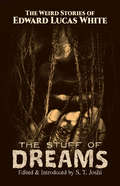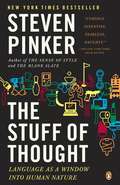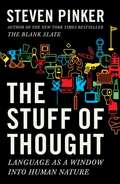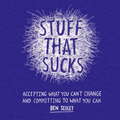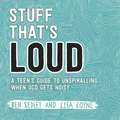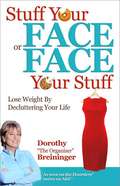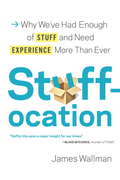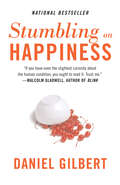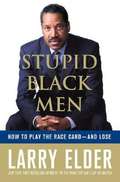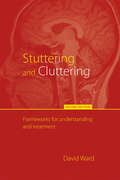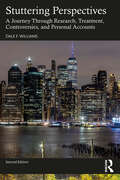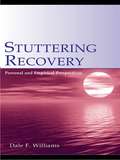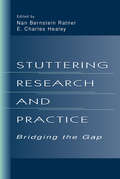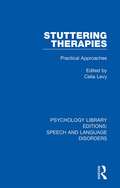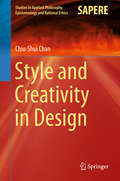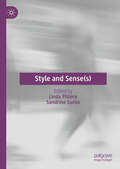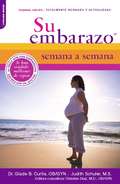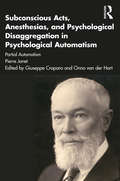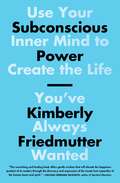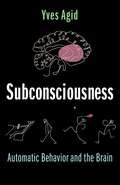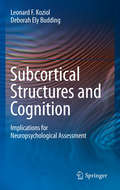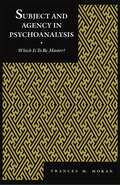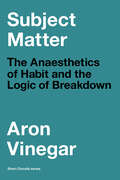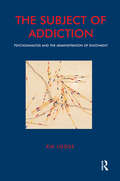- Table View
- List View
The Stuff of Dreams: The Weird Stories of Edward Lucas White (Dover Horror Classics)
by S. T. Joshi Edward Lucas WhiteThis original compilation presents chilling tales of terror by an unjustly neglected author. Inspired by the works of Edgar Allan Poe as well as his own vivid nightmares, Edward Lucas White (1866-1934) weaves a tapestry of weird stories populated by ghouls, monsters, a witch doctor, and creatures of ancient myths. The collection features White's most famous story, "Lukundoo," a gripping fable of an American explorer who incurs the wrath of an African sorcerer. Other tales include "Sorcery Island," an uncanny foreshadowing of television's The Prisoner, "The Flambeau Bracket," "The House of the Nightmare," "The Song of the Sirens," and five other stories. Additional selections include the haunting poems "Azrael" and "The Ghoula" and an essay in which the author reflects on the influence of dreams in his fiction. Editor S. T. Joshi provides an informative Introduction to White's life and work.
The Stuff of Thought: Language as a Window into Human Nature
by Steven PinkerThis New York Times bestseller is an exciting and fearless investigation of language Bestselling author Steven Pinker possesses that rare combination of scientific aptitude and verbal eloquence that enables him to provide lucid explanations of deep and powerful ideas. His previous books?including the Pulitzer Prize finalist The Blank Slate?have catapulted him into the limelight as one of today?s most important popular science writers. In The Stuff of Thought, Pinker presents a fascinating look at how our words explain our nature. Considering scientific questions with examples from everyday life, The Stuff of Thought is a brilliantly crafted and highly readable work that will appeal to fans of everything from The Selfish Gene and Blink to Eats, Shoots & Leaves.
The Stuff of Thought: Language as a Window into Human Nature
by Steven PinkerThe author explains how the mind works by examining the way we use words. Pinker takes on scientific questions - such as how language affects thought, and which of our concepts are innate - as well as questions from the headlines and everyday life.
Stuff That Sucks: Accepting what you can't change and committing to what you can (The\instant Help Solutions Ser.)
by Ben SedleyEach of us has thoughts that are painful at times; sometimes the pain is sadness, sometimes worry or anger or shame or grief or some feeling that you don't even have words for. If you are a young person struggling with your emotions, you do not want to be told that 'everyone feels like that' or that 'you will grow out of it'. You want to feel that your emotions are valid and that the person offering help truly understands how painful life can feel at times. With a strong emphasis on validation and compassion, Stuff That Sucks encourages you to accept your emotions rather than struggling against them. It also shows how to reconnect with what is really important to you, giving you the tools to help clarify your personal values and take steps towards living a life where those values can guide you in your day-to-day behaviour.
Stuff That's Loud: A Teen's Guide to Unspiralling when OCD Gets Noisy
by Ben Sedley Lisa CoyneDo you have thoughts that seem loud? Do your worries spiral out of control and then suck you in? Do intrusive thoughts show up and make you scared of doing certain things - or not doing things - a certain way? Do you ever get a feeling like something bad might happen? Does this loud stuff make you feel alone, or worse, crazy?First, you aren't alone - even if it sometimes feels that way. And second, you are not crazy. But you might be struggling with obsessive compulsive disorder (OCD). And while OCD can be difficult, you don't have to let it have power over you. Instead, you can live a life full of meaning, great relationships and joy with the help of this book.In Stuff That's Loud, you'll learn Exposure and Response Prevention (ERP) and ideas from Acceptance and Commitment Therapy (ACT) to help you break free from loud, spiralling OCD thoughts and behaviours:- You'll learn to be curious about the world around you- You'll use willingness to step forwards boldly - You'll develop flexibility skills to practice everywhere and everywhen- You'll focus on living a life that you give a $#@! aboutLife doesn't have to stay stuck any longer.
Stuff Your Face or Face Your Stuff: The Organized Approach to Lose Weight by Decluttering Your Life
by Dorothy BreiningerWhile organizing the lives of her many clients, Emmy-nominated organizing expert Dorothy Breininger learned to face her own stuff, and lost seventy-five pounds in the process. In this one-of-a-kind book she addresses weight loss from the much-needed perspective of what lies underneath our clutter—metaphorically, physically, and emotionally. Whether you're a packrat or a calorie-counter, a neat freak or a binge eater, Breininger reveals why, to be successful on the scale, you must first master the clutter within you and around you. With the same no-holds barred candor that resonates with TV viewers, she offers prescient advice to help anyone face their stuff, with an organized, step-by-step approach to either toss it, tame it, or tailor it to fit their lives. Filled with personal stories from clients, her own success story, and tips from fitness coaches and organizing experts, this imminently practical book gives everyone the tools to declutter their way to their dream size.
Stuffocation: Why We've Had Enough of Stuff and Need Experience More Than Ever
by James WallmanStuffocation is a movement manifesto for "experiential" living, a call to arms to stop accumulating stuff and start accumulating experiences, and a road map for a new way forward with the potential to transform our lives.Reject materialism. Embrace experientialism. Live more with less. Stuffocation is one of the most pressing problems of the twenty-first century. We have more stuff than we could ever need, and it isn't making us happier. It's bad for the planet. It's cluttering up our homes. It's making us stressed--and it might even be killing us. A rising number of us are already turning our backs on all-you-can-get consumption. We are choosing access over ownership, and taking our business to companies like Zipcar, Spotify, and Netflix. Fed up with materialism, we are ready for a new way forward. Trend forecaster James Wallman traces our obsession with stuff back to the original Mad Men, who first created desire through advertising. He interviews anthropologists studying the clutter crisis, economists searching for new ways of measuring progress, and psychologists who link stuffocation to declining well-being. And he introduces us to the innovators who are already living more consciously and with more meaning by choosing experience over stuff. Experientialism does not mean giving up all of our possessions. It is a solution that is less extreme but equally fundamental. It's about transforming what we value. Stuffocation is a paradigm-shifting look at our habits and an inspiring call for living more with less. It's the one important book you won't be able to live without. What People Are Saying About Stuffocation "James Wallman deftly hits upon a major insight for our times: that acquiring 'stuff' and 'things' is not nearly as meaningful as collecting experiences. Some of the happiest days of my life were when I had nothing and lived on a houseboat. Without stuff to tie me down, I felt completely free."--Blake Mycoskie, founder of TOMS and author of the New York Times bestseller Start Something That Matters "Stuffocation is a must-read. We think that more stuff will make us happier, but as the book nicely shows, we're just plain wrong. A great mix of stories and science, Stuffocation reveals the downside of more, and what we can do about it."--Jonah Berger, author of the New York Times bestseller Contagious "In Stuffocation, James Wallman offers a deeply important message by weaving contemporary social science into very engaging stories. Reading the book is such a pleasure that you hardly recognize you're being told that you should change how you live your life."--Barry Schwartz, author of The Paradox of Choice "With a sociologist's eye and a storyteller's ear, James Wallman takes us on a tour of today's experience economy from the perspective not of businesses, nor even of consumers per se, but of everyday people. In doing so, he identifies the rise of a new value system among those who are consciously replacing materialism with what he rightly calls experientialism. Spot on."--B. Joseph Pine II and James H. Gilmore, authors of The Experience Economy "Stuffocation explains how less but better stuff and space can lead to more time, more experiences, more connecting with people, and therefore more happiness. Designed right, small is the new big."--Graham Hill, founder, LifeEdited.com and TreeHugger.comFrom the Hardcover edition.
Stumbling on Happiness
by Daniel Gilbert* Why are lovers quicker to forgive their partners for infidelity than for leaving dirty dishes in the sink?* Why will sighted people pay more to avoid going blind than blind people will pay to regain their sight? * Why do dining companions insist on ordering different meals instead of getting what they really want? * Why do pigeons seem to have such excellent aim; why can't we remember one song while listening to another; and why does the line at the grocery store always slow down the moment we join it?In this brilliant, witty, and accessible book, renowned Harvard psychologist Daniel Gilbert describes the foibles of imagination and illusions of foresight that cause each of us to misconceive our tomorrows and misestimate our satisfactions. Vividly bringing to life the latest scientific research in psychology, cognitive neuroscience, philosophy, and behavioral economics, Gilbert reveals what scientists have discovered about the uniquely human ability to imagine the future, and about our capacity to predict how much we will like it when we get there. With penetrating insight and sparkling prose, Gilbert explains why we seem to know so little about the hearts and minds of the people we are about to become.From the Trade Paperback edition.
Stupid Black Men: How to Play the Race Card - and Lose
by Larry ElderIS LIFE UNFAIR FOR BLACK AMERICANS? IS RACIAL EQUALITY THE ANSWER TO EVERY QUESTION OF PUBLIC POLICY? IS A HUGE GROUP OF CITIZENS BEING KEPT DOWN BY "THE MAN"? RADIO HOST AND BESTSELLING AUTHOR Larry Elder has made a career out of being a thorn in the side of the conventional-wisdom crowd. He deflates the pompous and points out the completely logical truths hidden behind the nutty rhetoric and out-of-control pandering of politicians and the so-called leaders of a variety of special-interest groups. In Stupid Black Men, he takes on the mind-set of those people who always capture the most media attention-as well as masses of public money-people who say that racism is the root of all problems and who end up hurting precisely those they claim to be helping. Whether they are demagogues like Al Sharpton, established politicians like Hillary Clinton, or entertainers like Danny Glover, no one escapes Elder's cogent arguments and rapier wit. His sometimes hilarious and always infuriating examples of wrong-headedness skewer not just politicians for their smugness and hypocrisy but also actors, educators, religious leaders, and the "mainscream media" for keeping the story in the headlines. But Elder has a positive message, too: though they are fewer-and generally not as loudmouthed-there are leaders and role models today who want to sweep away race-based whining and urge everyone in America to share in the hard work, smart thinking, and optimism that make this country great.
Stuttering and Cluttering: Frameworks for Understanding and Treatment (Sources And Studies In World History Ser.)
by David WardStuttering and Cluttering provides a clear, accessible and wide-ranging overview of both the theoretical and clinical aspects of two disorders of fluency: stuttering and cluttering. This edition remains loyal to the idea that stuttering and cluttering can best be understood by first considering various overarching frameworks which can then be expanded upon, and provides a clear position from which to disentangle the often complex interrelationships of these frameworks.The book is divided into two parts, the first of which mainly deals with theory and aetiology, while the second focuses on clinical aspects of assessment, diagnosis and treatment. The book also provides frequent references across Parts I and II to help link the various areas of investigation together.This revised edition of Stuttering and Cluttering reflects the major changes in thinking regarding both theory and therapy that have taken place since the publication of the first edition. As well as those who stutter and clutter, the book will be invaluable for speech language therapy/speech language pathology students, practicing clinicians, psychologists and linguists around the world.
Stuttering Perspectives: A Journey Through Research, Treatment, Controversies, and Personal Accounts
by Dale F. WilliamsStuttering Perspectives is a highly engaging book that interweaves discussion and research about stuttering with personal accounts. Written in a reader-friendly and informal style, the book considers stuttering from a variety of angles, providing the reader with a nuanced and holistic view. In this way, topics such as therapy, support groups, listener reactions, and many others are not only explained within the context of current research, but also illustrated with lively examples demonstrating the stuttering experience. Fully updated in its second edition, the book includes new stories, additional discussion questions, and inclusion of contemporary stuttering issues not contained in the original version. This book is highly relevant reading for speech and language professionals, as well as students of communication sciences and disorders. It will also be of great interest to people who stutter and anyone with an interest in fluency disorders.
Stuttering Recovery: Personal and Empirical Perspectives
by Dale F. WilliamsStuttering Recovery: Personal and Empirical Perspectives is a highly original and engaging book serving to not only educate readers on topics related to stuttering, but also to stimulate discussion. The author interweaves personal accounts of people who stutter with informational chapters highlighting up-to-date research on recovery-related issues such as therapy, support groups, listener reactions, risk-taking, and dealing with family members and significant others.Reader-friendly and understandable, this book incorporates various perspectives to teach and illustrate the different aspects of recovery. Chapters are paired with stories presenting all sides of the recovery process -- the humorous and serious, the uplifting and frustrating, the thoughtful and emotional, and everything in-between. The result is a text that is entertaining and instructive.Stuttering Recovery: Personal and Empirical Perspectives is intended for undergraduate and graduate students, clinicians, speech-language professionals, people who stutter, significant others, and anyone else who has an interest in fluency disorders.
Stuttering Research and Practice: Bridging the Gap
by Nan Bernstein Ratner and E. Charles HealeyCurrent approaches to treating stuttering do not reflect the new understanding of its nature which has emerged from recent studies. This book brings together speech scientists and clinicians to discuss the best ways to close the perceived gap and maximize the effectiveness of treatment. Together, the chapters offer a comprehensive state-of-the-art overview of the complexities of stuttering and its remediation. Genetic, neuropsychological, behavioral, and often-neglected affective and cognitive factors are all considered. Preferred methodologies for empirical investigation are described, and specific examples of applied clinical research designs are provided. The book will be crucial reading for all those professionally concerned with fluency disorders and their students.
Stuttering Therapies: Practical Approaches (Psychology Library Editions: Speech and Language Disorders)
by Celia LevyOriginally published in 1987, this book presented new ideas on the treatment of stuttering, by leading authorities within Britain at the time. There are chapters on children and adolescents, as well as on adults. In each chapter the author describes the therapeutic approach, how it fits into general views on the nature of stuttering, the clients for which it is appropriate, and possible methods of evaluation. The book is aimed at speech therapists and psychologists and provided an important up-date of the subject for practitioners.
Style and Creativity in Design
by Chiu-Shui ChanThis book looks at causative reasons behind creative acts and stylistic expressions. It explores how creativity is initiated by design cognition and explains relationships between style and creativity. The book establishes a new cognitive theory of style and creativity in design and provides designers with insights into their own cognitive processes and styles of thinking, supporting a better understanding of the qualities present in their own design. An explanation of the nature of design cognition begins this work, with a look at how design knowledge is formulated, developed, structured and utilized, and how this utilization triggers style and creativity. The author goes on to review historical studies of style, considering a series of psychological experiments relating to the operational definition, degree, measurement, and creation of style. The work conceptually summarizes the recognition of individual style in products, as well as the creation of such styles as a process before reviewing studies on creativity from various disciplines, presenting case studies and reviewing works by master architects. Readers will discover how creativity is initiated by design cognition. A summary of the correlations between creativity and style, expressed as a conceptual formula describing the cognitive phenomenon of style and creativity concludes the work. The ideas presented here are applicable to all design fields, allowing designers to comprehend and improve their design processes to produce creative, stylistically unique products.
Style and Sense(s)
by Sandrine Sorlin Linda PillièreThis edited volume celebrates cutting-edge research in stylistics and, more specifically, recent work on sense and the senses. The title originated in the Poetics and Linguistics Association (PALA) 2022 conference and marks the 40th onsite event by showcasing some of the excellent papers delivered on that occasion. The selected chapters fall into 4 parts each of which gives pride of place to how style makes sense and how senses make style. The chapters follow research in neuroscience and sociocognition, investigate how body and mind are inextricably linked through embodied meaning; how emotions are both conveyed and perceived; and how impressions, thoughts and worldviews can be induced by a certain style. The apprehension of the senses is carried through a variety of theories (cognitive linguistics and stylistics, ecostylistics, phenomenology, simulation theory, enactivism, metaphor theory, Text World Theory) and is applied to various genres (poetry, novels, short stories, detectivefiction, restaurant reviews) and media (the oral vs written tradition, ekphrasis, and semiotic transfers). This book will be of interest to students and academics in stylistics, cognitive linguistics, discourse analysis, ecostylistics, and multimodality.
Su Embarazo Semana a Semana
by Glade B. Curtis Judith SchulerWith millions of copies sold,Your Pregnancy Week by Weekis the best-selling, doctor-authored pregnancy and childbirth guide available. A translation of the up-to-date and expanded fifth edition,Su Embarazo Semana a Semanawill be the most medically current and comprehensive Spanish language guide for pregnant couples on the market. Organizing information in the medically appropriate, focused, and popular way-in weekly increments instead of monthly-each of the forty chapters ofSu Embarazo Semana a Semanafeatures: Detailed descriptions of baby’s growth and development each weekClear illustrations that show how both mother and baby are changing and growingDetailed descriptions of what readers may be experiencing each week, from average weight gain to feeling baby moveInformation about both routine and special medical tests that may be requiredTips on nutrition, overall maternal health, and how these things affect baby
Su Embarazo Semana a Semana
by Glade B. Curtis Judith SchulerWith millions of copies sold, Your Pregnancy Week by Week is the best-selling, doctor-authored pregnancy and childbirth guide available. A translation of the up-to-date and expanded fifth edition, Su Embarazo Semana a Semana will be the most medically current and comprehensive Spanish language guide for pregnant couples on the market.Organizing information in the medically appropriate, focused, and popular way-in weekly increments instead of monthly-each of the forty chapters of Su Embarazo Semana a Semana features: Detailed descriptions of baby's growth and development each weekClear illustrations that show how both mother and baby are changing and growingDetailed descriptions of what readers may be experiencing each week, from average weight gain to feeling baby moveInformation about both routine and special medical tests that may be requiredTips on nutrition, overall maternal health, and how these things affect baby
Subconscious Acts, Anesthesias and Psychological Disaggregation in Psychological Automatism: Partial Automatism
by Pierre JanetPierre Janet’s L'Automatisme Psychologique, originally published in 1889, is one of the earliest and most important books written on the study of trauma and dissociation. Here it is made available, in two volumes, in English for the first time, with a new preface by Giuseppe Craparo and Onno van der Hart. The second volume, Subconscious Acts, Anesthesias, and Psychological Disaggregation in Psychological Automatism, covers four main topics. Beginning with an examination of subconscious acts, Janet first assesses partial catalepsies, subconscious acts, and posthypnotic suggestions, then proceeds to a consideration of anesthesias and simultaneous psychological existences. This is followed by discussion of several forms of psychological disaggregation, including spiritism, impulsive madness, hallucinations, and possessions. Finally, Janet considers elements of mental weakness and strength, from misery to judgement and will. Janet’s work, with its many descriptions of dissociative actions and the dissociative personality, will help clinicians and researchers to develop insight in trauma-related dissociation, and to become more adapt at relating to their patients’ dissociative actions. This seminal work will be of great interest to researchers and students of psychoanalysis, philosophy, and modernism, as well as psychotherapists and psychoanalysts working with clients who have experienced trauma. It is accompanied by Catalepsy, Memory, and Suggestion in Psychological Automatism: Total Automatism.
Subconscious Power: Use Your Inner Mind to Create the Life You've Always Wanted
by Kimberly FriedmutterActivate the raw power of your subconscious to create the life you've always wanted, using six essential lessons from one of the world’s most renowned hypnotherapists.Unsatisfying careers. Volatile, unhealthy relationships. Unfulfilled dreams. Too many of us are living lives that fall short of what we truly desire. But as celebrity hypnotist Kimberly Friedmutter explains in this life-changing book, not only is it possible to design the life of your dreams, but the power to do so lies within you, in your subconscious mind. The subconscious is the root of your true power and desire; it's your inner eight-year-old, your authentic self. It is the honest compass that will lead you to a life of happiness, so long as you are able to follow its direction. We all have the power to access it—children do so effortlessly—but as we grow up we’re taught to stop daydreaming and to follow society’s rules, which makes us disconnect from our subconscious, often with tragic results. In Subconscious Power, Kimberly guides you through six principles that bring your conscious mind in line with your subconscious desires. She shares practical, three-minute exercises that will help you transform your relationships, find true love, lose weight after years of struggling with the scale, overcome addictions, and achieve new career successes and heights. Featuring inspiring success stories and the practical tools you need to make meaningful change, Subconscious Power will empower you to stop being a passive participant in a life you don't love, and to actively choose the life you truly desire.
Subconsciousness: Automatic Behavior and the Brain
by Yves AgidWe are conscious of only a small fraction of our lives. Because the brain constantly receives an enormous quantity of information, we need to be able to do things without thinking about them—to act in “autopilot” mode. Automatic behaviors—the vast majority of our activities—occur without our conscious awareness, or subconsciously. Yet the physiological basis of subconsciousness remains poorly understood, despite its vast importance for physical and mental health.The neurodegenerative disease expert Yves Agid offers a groundbreaking and accessible account of subconsciousness and its significance. He pinpoints the basal ganglia—the ancient “basement of the brain”—as the main physiological hub of the subconscious. Agid examines its roles in the control and production of automatic behavior, including motor, intellectual, and emotional processes. He highlights the consequences for various brain pathologies, showing how malfunctions of the subconscious have clinical repercussions including not only abnormal involuntary movements, as seen in Parkinson’s disease, but also psychiatric disorders such as obsessive-compulsive disorders and depression. Based on this understanding, Agid considers how seeing the basal ganglia as a therapeutic target can aid development of potential new treatments for neurological and psychiatric disorders.Shedding new light on the physiological bases of our behavior and mental states, this book provides an innovative exploration of the complexities of the mind, with implications ranging from clinical applications to philosophy’s thorniest problems.
Subcortical Structures and Cognition
by Leonard F. Koziol Deborah Ely BuddingClinical psychologists and neuropsychologists are traditionally taught that cognition is mediated by the cortex and that subcortical brain regions mediate the coordination of movement. However, this argument can easily be challenged based upon the anatomic organization of the brain. The relationship between the prefrontal cortex/frontal lobes and basal ganglia is characterized by loops from these anterior brain regions to the striatum, the globus pallidus, and the thalamus, and then back to the frontal cortex. There is also a cerebrocerebellar system defined by projections from the cerebral cortex to the pontine nuclei, to the cerebellar cortex and deep cerebellar nuclei, to the red nucleus and then back to thalamus and cerebral cortex, including all regions of the frontal lobes. Therefore, both the cortical-striatal and cortical-cerebellar projections are anatomically defined as re-entrant systems that are obviously in a position to influence not only motor behavior, but also cognition and affect. This represents overwhelming evidence based upon neuroanatomy alone that subcortical regions play a role in cognition. The first half of this book defines the functional neuroanatomy of cortical-subcortical circuitries and establishes that since structure is related to function, what the basal ganglia and cerebellum do for movement they also do for cognition and emotion. The second half of the book examines neuropsychological assessment. Patients with lesions restricted to the cerebellum and/or basal ganglia have been described as exhibiting a variety of cognitive deficits on neuropsychological tests. Numerous investigations have demonstrated that higher-level cognitive functions such as attention, executive functioning, language, visuospatial processing, and learning and memory are affected by subcortical pathologies. There is also considerable evidence that the basal ganglia and cerebellum play a critical role in the regulation of affect and emotion. These brain regions are an integral part of the brain's executive system. The ability to apply new methodologies clinically is essential in the evaluation of disorders with subcortical pathology, including various developmental disorders (broadly defined to include learning disorders and certain psychiatric conditions), for the purpose of gaining greater understanding of these conditions and developing appropriate methodologies for treatment. The book is organized around three sources of evidence: neuroanatomical connections; patients with various disease processes; experimental studies, including various imaging techniques. These three sources of data present compelling evidence that the basal ganglia and cerebellum are involved in cognition, affect, and emotion. The question is no longer if these subcortical regions are involved in these processes, but instead, how they are involved. The book is also organized around two basic concepts: (1) the functional neuroanatomy of the basal ganglia and the cerebellum; and (2) how this relates to behavior and neuropsychological testing. Cognitive neuroscience is entering a new era as we recognize the roles of subcortical structures in the modulation of cognition. The fields of neuropsychology, cognitive psychology, neuropsychiatry, and neurology are all developing in the direction of understanding the roles of subcortical structures in behavior. This book is informative while defining the need and direction for new paradigms and methodologies for neuropsychological assessment.
Subject and Agency in Psychoanalysis: Which Is to Be Master?
by Frances MoranPsychoanalysis works with words, words spoken by a subject who asks that the analyst listen. This is the belief that underlies Francis Moran's rewarding exploration of a central problem in psychoanalytic theory-namely, the separation of the concepts of subject and agency. Subject and Agency in Psychoanalysis contends that Freud simultaneously employs two frameworks for explaining agency-- one clinical and one theoretical. As a result, Freud's exploration of agency proceeds from two logically incompatible assumptions. The division between these assumptions is a part of Freud's psychoanalytic legacy. Moran reads the Freudian inheritance in light of this division, showing how Klein and Hartmann's theoretical concepts of subject are adrift from the subject who speaks in analysis. Moran also shows that while Lacan's subject provides more focus on this issue, Lacan reverts to the Freudian division in his use of logically contradictory assumptions concerning the location of agency. Drawing on contemporary theory development, from Lacanian innovations to the social theories of Anthony Giddens, Moran proposes a new and fertile approach to a fundamental problem, significantly narrowing the gap between psychoanalytic theory and practice.
Subject Matter: The Anaesthetics of Habit and the Logic of Breakdown (Short Circuits)
by Aron VinegarA theorization of habit that emphasizes its excessive and unsettling qualities rather than its mediating, adaptive, and stabilizing functions.Subject Matter offers a bold counterpoint to prevalent conceptions of habit characterized by bodily fluidity and ease, as the stabilizing foundation of an emerging subjectivity, or, more negatively, as a numbing and deadening force. Instead of facilitating the coordination of action with goal and self with environment, habit appears here as a disruptively recursive operation with extreme ontological implications that are often more quotidian than exceptional. Vinegar theorizes habit&’s more perturbing aspects, from repetition compulsion to kenosis to breakdown, through an encounter between Hegel&’s philosophy (of habit), psychoanalytic dimensions of repetition, Tom McCarthy&’s novel Remainder, and Omer Fast&’s feature-length film interpretation of the novel.Vinegar starts with the premise that habit is an &“unhappy mediator,&” a disturbance of the very medium and milieu that is constitutive of the subject. Subject Matter pays close attention to those aspects of habit that are usually considered deviations from, or potential threats to, habit proper and that generate a logic of breakdown: automaticity, mechanization, thingness, inertia, and fixity. By plotting a topology of habit&’s unbearability through detailed accounts of its manifestation in writing, art, aesthetics, and visuality—and through an attentiveness to the unbalanced nonrelations between mediation and immediacy, being and having, fixity and fluidity, vanishing and overflowing, abbreviation and excess, beginning and ending—Vinegar exposes habit&’s failure to mediate and inhabit. In doing so, he offers new and counterintuitive insights into how habit generates the unruly grounds it is supposed to settle, thus allowing us to ask how we might break down differently.
The Subject of Addiction: Psychoanalysis and The Administration of Enjoyment
by Rik LooseDrugs and drug use are an integral part of human culture. Yet we know hardly anything about drugs, at least not the kind of knowledge that would help us to understand how drugs affect people and how people beome addicted to drugs. This is most surprising in the light of the vast amount of knowledge accumulated in the sciences. Psychoanalysis might not be an obvious choice for the treatment of addiction. Nevertheless, it is in an excellent position to make a contribution to a problem that has so far defied much of our understanding. By inviting people to speak about themselves, psychoanalysis has established a unique way of collecting clinical material, a material that surely must be immediately relevant coming as it does from the horse's mouth. With addiction on the increase, this fact alone justifies the necessity for a different approach.Providing a theoretical foundation for the argument that psychoanalysis should be seriously considered, and where possible incorporated into the treament of addicts, this thoughtful and innovative book can serve as an orientation in the ongoing front-line battle with addicts and addiction.
